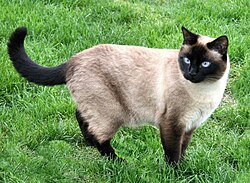Point coloration
This article relies largely or entirely upon a single source. (May 2009) |

Point coloration refers to animal coat coloration with a pale body and relatively darker extremities, i.e. the face, ears, feet, tail, and (in males) scrotum. It is most recognized as the coloration of Siamese and related breeds of cat, but can be found in rabbits and horses as well.
Point coloration in cats
[edit]Point coloration in cats is a form of partial albinism resulting from a mutation in tyrosinase, an enzyme involved with melanin production. The mutated enzyme is heat-sensitive; it fails to work at normal body temperatures, but becomes active in cooler areas of the skin.[1] As a result, dark pigment is limited to the coldest areas of the body, that is, the extremities. Pointed kittens are born white, since the womb is uniformly warm. As the kitten ages, the cooler areas darken while warmer areas remain cream to white in color. Points are not limited to solid colors or dark colors. It is possible to have a red (orange color) or fawn (pale warm gray) point. It is also possible to have a tortoiseshell or tabby point. This coloration is also sometimes called colorpoints.
Because of this restriction of pigment, pointed cat's eyes are always some shade of blue, because the top layer of the iris is not covered in another color, letting the blue show through. The back of the eye also lacks pigment, giving these cats' pupils an eerie red reflection in the dark, unlike a normally pigmented cat's green to blue shine.
The point gene is carried on the C locus, where pure albinism is also carried. It is shown with the sign cs, and needs two alleles of cs for the points to be expressed. The point gene is recessive to the tabby gene. Also carried on the C locus is the gene for the sepia pattern. This is the darkest of all of the pigment restricting patterns, and pigment is only paled at the warmest point in the body, the abdomen. This pattern's gene is represented by cb. When a cat carries the genes cs and cb, the mink pattern is formed, in which the pigment distribution is between a sepia and a point cat.
Point coloration in horses
[edit]

In horses, point coloration is produced by the action of the Agouti gene, which acts on the extension gene, when present, to suppress black color to the extremities of the horse; the legs, mane, tail and tips of the ears. If the extension gene is not present, the effect of agouti is not visible. Points are most typically seen on a bay-colored horse that has a black mane, tail, legs and ear tips while the body and head will show the underlying chestnut or "red" base color. Other genes or white markings may affect a horse's coat color in addition to agouti, and if present, can alter or suppress black hair color, which will mask any point coloration. Any horse breed may have point coloration with the exception of a very small number of horse breeds where humans have specifically used selective breeding to eliminate coloring produced by the agouti gene.
Horse coat colors with visible points
[edit]Rabbit breeds with points
[edit]
Cat breeds with points
[edit]- Balinese
- Birman
- Colorpoint Shorthair
- Himalayan
- Javanese
- Peterbald
- Siamese
- Snowshoe
- Ragdoll
- Exotic Shorthair
References
[edit]- ^ Lua error in package.lua at line 80: module 'Module:Citation/CS1/Suggestions' not found.

